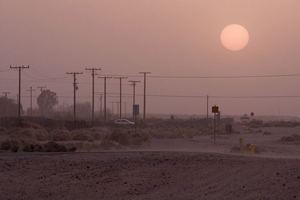 Last fall, Kirt Emery was on his motorcycle, cruising up the 99 freeway over the mountains from Santa Barbara to Bakersfield, California, when he saw the dust storm materializing in front of him. Visibility was low, but he wanted to get through it as quickly as he could, so he held his breath and hammered his bike up to 100 miles per hour.
Last fall, Kirt Emery was on his motorcycle, cruising up the 99 freeway over the mountains from Santa Barbara to Bakersfield, California, when he saw the dust storm materializing in front of him. Visibility was low, but he wanted to get through it as quickly as he could, so he held his breath and hammered his bike up to 100 miles per hour.
As the head of epidemiology for the Bakersfield Public Health Services Department, Emery has spent the past two decades studying dust like this—and avoiding it at all costs. He knows all too well what could happen to him if he got sick: the expensive medications with their nasty side affects, the uncertainty of whether he could be ill for the rest of his life.
It’s been more than 20 years since he moved to Bakersfield, and so far, he’s still healthy. That makes him one of the lucky ones. For many people living in places like Bakersfield, and throughout much of California’s Central Valley, dust can be deadly.
Coccidioidomycosis, also known as cocci, or valley fever, is a fungal disease endemic to the soils of the Southwest, in places like Arizona, Nevada, New Mexico, Texas and Utah. In California, it’s rampant across the Central Valley, an area just slightly smaller than West Virginia that grows about a third of the country’s produce. About 30 percent of all valley fever cases nationwide occur in the Central Valley each year.
Valley fever has perplexed doctors and patients alike for more than a century. Symptoms range from mild fatigue to incapacitating, flesh-eating infections, and despite decades of research, advances in treatment and pushes to develop a vaccine have been painfully slow. There’s virtually no way to guard against inhaling the spores that cause valley fever, as most masks can’t filter out the microscopic dust particles that carry the spores through the air and into the lungs. Getting infected with valley fever can be as simple as driving through Bakersfield with the windows down—or in Emery’s case, on a motorcycle.
Read more in The Atlantic.
Photo courtesy of David~O/Flickr.

